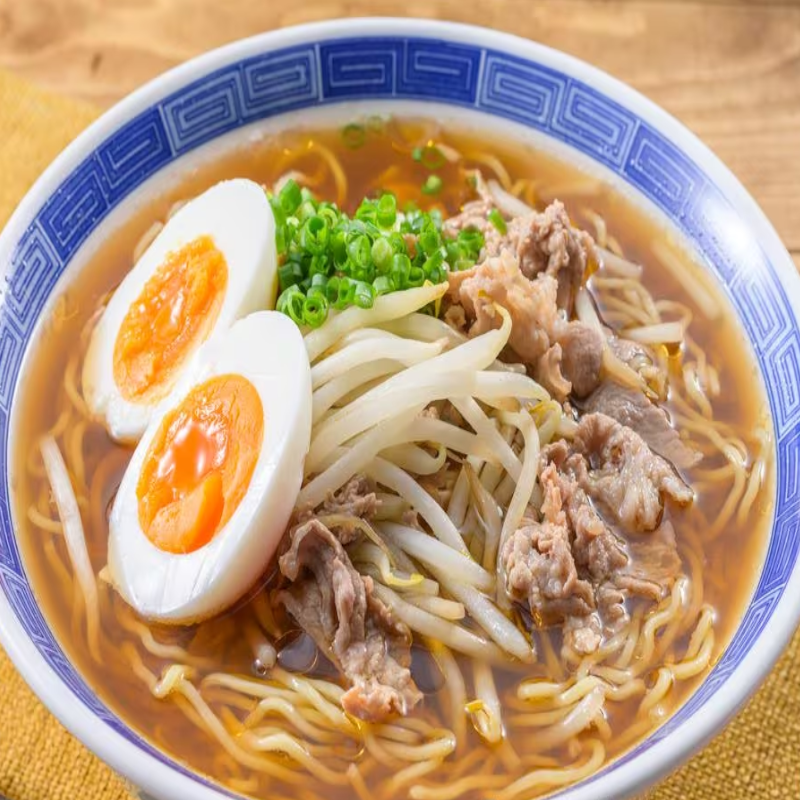Shio Ramen (塩ラーメン)
 Garanties sécurité
Garanties sécurité
(à modifier dans le module "Réassurance")
 Politique de livraison
Politique de livraison
(à modifier dans le module "Réassurance")
 Politique retours
Politique retours
(à modifier dans le module "Réassurance")
Shio Ramen (塩ラーメン)
Shio Ramen (塩ラーメン) is one of the oldest and simplest variations of ramen, characterized by a light, salty broth, often considered more subtle than other ramen types based on miso or soy sauce. "Shio" means "salt" in Japanese, reflecting the main seasoning element of the broth. This dish is emblematic of Japanese cuisine, and each region can have its own interpretation of ramen, with broths made from chicken, pork, or even seafood.
Origin and History
Ramen, in general, has roots in Chinese cuisine, but it became deeply integrated into Japanese culture, especially after World War II. Shio ramen was one of the earliest variations, thanks to its simple broth. Originally, ramen was made primarily with chicken broth, and shio ramen was a clearer, lighter version compared to richer broths like miso or tonkotsu (pork bones).
Characteristics of Shio Ramen
The broth for shio ramen is typically made from chicken (often using carcasses or wings) and is sometimes enriched with kombu (seaweed), niboshi (dried anchovies), ginger, and other spices like garlic and onion. This broth, once filtered and seasoned, is very clear with a slightly salty flavor but also umami, thanks to the addition of mirin and sake, which bring a touch of sweetness and depth.
Classic toppings include chashu (braised pork), marinated eggs (ajitama), fermented bamboo shoots (menma), soybean sprouts, green onions, and nori (dried seaweed). These ingredients provide a balance of textures and flavors that complement the lightness of the broth.
Shio Ramen Recipe with Chashu (チャーシュー), Marinated Eggs (味玉), Menma (メンマ), Nori (海苔), Soybean Sprouts, and Green Onions (青ねぎ)
Here is a detailed recipe to prepare delicious shio ramen at home with all the classic toppings, including chashu, marinated eggs, menma, nori, soybean sprouts, and green onions.
Ingredients:
For the Broth (Shio Ramen):
- 1 kg of chicken (carcasses or wings)
- 2 liters of water
- 1 piece of kombu (10 cm)
- 10 g of niboshi (dried anchovies)
- 1 onion, halved
- 3 cloves of garlic, crushed
- 1 piece of ginger (5 cm), sliced
- 1 tablespoon of salt
- 1 tablespoon of sake
- 1 tablespoon of mirin
- Aromatic oil (sesame oil or fish oil, depending on preference)
For the Chashu (チャーシュー):
- 500 g of pork belly
- 100 ml of soy sauce
- 50 ml of sake
- 50 ml of mirin
- 2 tablespoons of sugar
- 3 cloves of garlic, crushed
- 1 piece of ginger (5 cm), sliced
- 2 green onions, chopped into pieces
For the Marinated Eggs (味玉):
- 4 eggs
- 100 ml of soy sauce
- 100 ml of mirin
- 100 ml of water
- 1 tablespoon of sugar
For the Toppings:
- Menma (メンマ): Fermented bamboo shoots, about 100 g (available in Asian markets)
- Nori (海苔): Dried seaweed sheets, cut into squares
- Soybean sprouts: About 100 g, quickly blanched
- Green onions (青ねぎ): Sliced thinly for garnish
For the Noodles:
- 400 g ramen noodles (thin and straight)
Preparation:
Preparing the Shio Broth:
- Prepare the Chicken Broth: In a large pot, add the chicken carcasses, water, kombu, niboshi, onion, garlic, and ginger. Bring to a boil, then reduce the heat and let it simmer gently for 2-3 hours.
- Seasoning: Remove the solid ingredients from the broth. Add the salt, sake, and mirin. Let it simmer for another 10 minutes to blend the flavors.
- Add Aromatic Oil: Just before serving, add a tablespoon of aromatic oil to each bowl.
Preparing the Chashu:
- Sear the Pork: Brown the pork belly on all sides in a hot pan.
- Braise: In a pot, combine the soy sauce, sake, mirin, sugar, garlic, ginger, and green onions. Add the pork belly and simmer on low for 2 hours, turning the meat occasionally.
- Cool and Slice: Remove the pork from the sauce and let it cool. Slice thinly just before serving.
Preparing the Marinated Eggs (味玉):
- Cook the Eggs: Bring water to a boil. Gently place the eggs in and cook for 7 minutes to achieve a creamy yolk. Cool them immediately in ice water.
- Marinate: Mix the soy sauce, mirin, water, and sugar in a resealable bag. Peel the eggs and place them in the marinade. Let them marinate in the fridge for at least 4 hours (ideally overnight).
Preparing the Noodles:
- Cook the Noodles: Cook the ramen noodles according to the package instructions. Drain and divide them into serving bowls.
Assembling the Shio Ramen:
- Pour the Broth: Pour the hot broth over the noodles in each bowl.
- Add the Toppings: Arrange slices of chashu, halved marinated eggs, menma, soybean sprouts, and green onions on the noodles. Add a square of nori to the side of the bowl.
- Serve: Serve immediately, allowing each guest to savor the blend of flavors and textures.
Chashu (チャーシュー)
Chashu is a signature topping in ramen, often made with pork belly braised in a sweet and salty soy sauce. When cooked properly, it becomes incredibly tender, almost melting, and offers a rich meaty flavor that complements the salty broth of shio ramen. Chashu is thinly sliced before being added to the ramen to add a layer of richness.
Marinated Eggs (味玉)
Marinated eggs, or ajitama, are another essential ramen element. These eggs are cooked perfectly to have a creamy yolk and then marinated in a soy sauce, mirin, and sugar-based sauce. They add a touch of sweetness and a perfect contrast to the saltiness of the broth.
Other Toppings:
- Menma (メンマ): Fermented bamboo shoots are a classic addition to many types of ramen. They have a slightly crunchy texture and an umami flavor.
- Soybean Sprouts: These small sprouts bring a slight bitterness and a refreshing crunch to the dish.
- Nori (海苔): Dried seaweed sheets add a subtle oceanic flavor that complements the other ramen tastes.
- Green Onions (青ねぎ): Sliced green onions bring freshness and a slight sharpness, helping balance the richness of the broth and other toppings.
The Noodles:
Ramen noodles are typically thin and straight for shio ramen, unlike other types of ramen that may have thicker or curly noodles. The noodles should be cooked al dente, which helps maintain their texture even after being submerged in the hot broth.
Regional Variations:
As with all types of ramen, shio ramen varies from region to region in Japan. For example, in Sapporo, in the northern part of Japan, ramen is sometimes made with pork broth, while in Kyushu, it may be enriched with sesame or other toppings. However, the base of shio ramen remains true to a lighter and clearer preparation.
Conclusion
Shio Ramen is a dish that is both simple and refined, with its pure broth and careful toppings creating a perfect harmony of flavors. It’s an excellent choice for those who prefer a lighter ramen while still enjoying the depth of traditional Japanese cuisine. Enjoy and let yourself be swept away by this delicious noodle soup!


